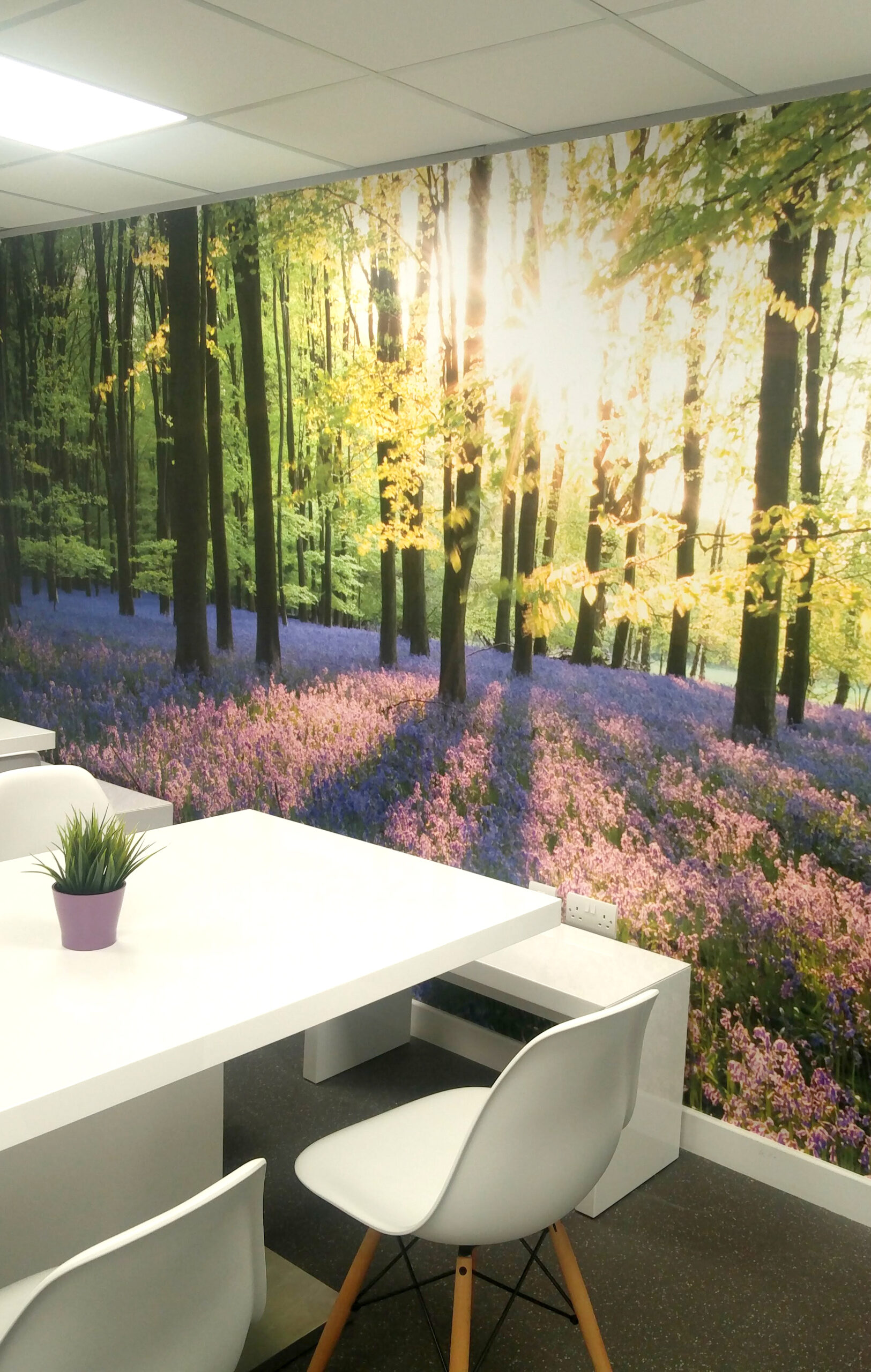
Working with commercial interior designers over the last 8 years or so we have come across some gems of insight from clients and users of these spaces. We have produced and installed prints from large comic-strip prints, geometric shapes, photos of cityscapes, flock wallpaper prints, extreme close-ups of flowers, hand painted artwork, right through to stunning images of the sun streaming through a bluebell wood. And this is what we have found.
There is always a time and place for a graphic-style wallpaper print, but if you can chose between wallpaper and a photographic mural, we have found a photographic mural is better for the space. This is because as humans we have existed in synergy with the natural world around us, our ancestors for thousands of years were intimately linked with the wide open spaces, grasslands, moors and forests. Because of this there is something in us that responds to a photograph of nature, a nice printed wallpaper does not have the ability to transport us to other worlds or spark the imagination quite like a beautiful image of the countryside does.
Our top tips when using wall art.
- In a small confined space use images with a horizon line. This takes the eye away into the distance and reduces any sense of claustrophobia.
- Colour matters, purples and pastel colours in images have a calming effect. Alternatively, bright colours produce a sense of fun and excitement, these would be great for fun brands or products and also areas for children.
- Feng Shui expert Denise O’Dwyer says that wood is good for learning environments. Images of some dominant trees in a landscape or forests would work.
- Denise also suggests avoiding aggressive images in bedrooms areas e.g. fierce tigers as the energy is too stimulating. Instead keep the images in a bedroom gentle and calm.
- Keep busy images for larger spaces, users can stand back and see the full image without feeling overawed.
- Black and white images may look cool and arty, but they often leave a room feeling cold, so only use in the right environment.
- Big or close-up images in small rooms are not recommended, they may look great on the design layout on a computer screen, but in reality they can have a negative effect on the space becoming overbearing and claustrophobic.
- If there is a focal point on the image don’t cover it up with a cupboard or shelves, think about the real world space. This seems a simple one, but knowing the space is crucial.
- An image of a bleak headland in Scotland may look rugged and beautiful to some, but it can make a room feel cold and unwelcoming. Images from summer or spring tend to make us feel better.
- A tropical beach scene may make the viewer dream of holidays, which can be useful for dental practices or healthcare environments where patients wish to think about something other than the impending appointment.
- Close up images of plants and flowers can add a touch of nature into a room where a landscape would not be useful, for instance in a boardroom. You do not want to mentally transport people off to their favourite hiking destination while the Chairman is trying to discuss a significant plan for the company.
- We have seen great use of a vertical or horizontal banner which has a photographic image on, these images break up a larger areas, but offer glimpses of nature for the users to enjoy as they move around space.
- In buildings where rooms with little or no natural light, using a photographic image filled with blue skies and sunlight can trick the brain into thinking the space is bright and airy.
Final thoughts from us are, that it is crucial to understand the space, doing a site survey and an onsite meeting are hugely important in our experience, architects drawings only tell you half the story.
Just one brilliant image can totally transform a space.
Wall Glamour transform spaces using wall murals and graphics. We turn blank walls into visual treats which have a significant positive effect on the users of those spaces. Our products have featured on several TV shows, and we have installed bespoke projects throughout the UK.
Wall Glamour works with leading commercial interior designers and architects to install wall murals and graphics into businesses, start-ups, gyms, schools, cafés and healthcare environments.
Next Post.
These are some of the questions that are useful to keep in mind when onsite, is the space small, large or an awkward shape? Are there cupboards/wardrobes or units at high-level, or are there steps or columns in the wall that you need to consider? Does the door open inward onto the only free wall or is there space opposite the door for a mural, so people to see it as they enter? Are there fixtures on the wall like alarm boxes, electrical trunking or air-conditioning that will obstruct the image?